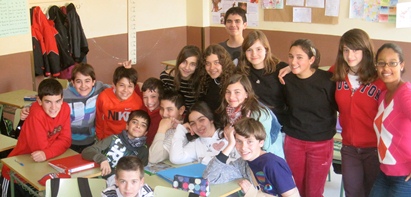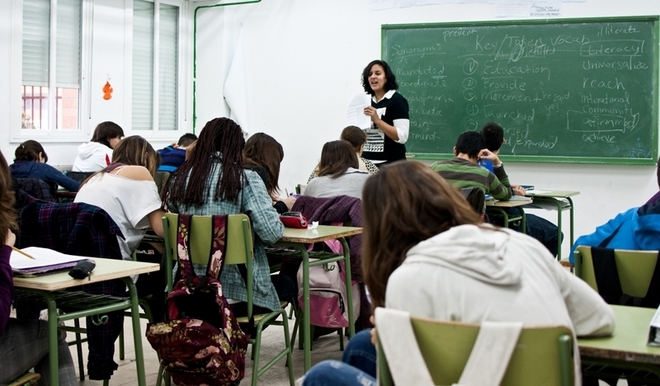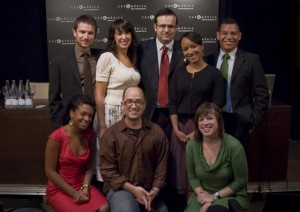 The world begins and ends in Amrika. For my parents, that would be “um-REE-kah,” the Farsi-infused pronunciation of America. This was my family’s motto when we joined the multitude of transplanted souls who traded the familiarity of home for an embryonic opportunity of a better life. The phrase can be perceived negatively, suggesting a myopic America distant from the rest of the world. However, we were the uprooted, the mythical “huddled masses” and “the homeless, tempest-tossed” engraved on Lady Liberty. Our definition was born from a gold-plated dream that drew millions of immigrants to the United States. The dream—and its sometimes ugly underbelly—is always different, but for my parents it meant building the life that we could not have back in Iran.
The world begins and ends in Amrika. For my parents, that would be “um-REE-kah,” the Farsi-infused pronunciation of America. This was my family’s motto when we joined the multitude of transplanted souls who traded the familiarity of home for an embryonic opportunity of a better life. The phrase can be perceived negatively, suggesting a myopic America distant from the rest of the world. However, we were the uprooted, the mythical “huddled masses” and “the homeless, tempest-tossed” engraved on Lady Liberty. Our definition was born from a gold-plated dream that drew millions of immigrants to the United States. The dream—and its sometimes ugly underbelly—is always different, but for my parents it meant building the life that we could not have back in Iran.
I was eight years old when we moved from Tehran to Atlanta.
The journey was overwhelming – from the initial shock of cultural dislocation, to the slow process of adapting and finally integrating into my surrogate home. Resident alien, cultural chameleon, naturalized citizen, hyphenated American, Persian-or-Iranian, and just plain American—it was evolution on a small scale. I faced a whirlwind of triumphs and failures as my coming-of-age story collided into the uncharted territories of coming-to-America. The experience left a few scabby memories but no permanent scars.
I have come a long way since my days as a shy Middle Eastern girl, but once again, I find myself as a foreigner in a new country. Exactly one month from today, I will celebrate a year abroad in Valencia, Spain with the Fulbright U.S. Student Program. The grant allowed me to research under the mentorship of Dr. Almudena Ramón Cueto, a renowned spinal cord injury investigator. My project examines the regenerative potential of olfactory cell transplants as a treatment for people living with paralysis, a condition that currently has no cure. As a pre-medical student and a compulsive planner, you would think that going for a Fulbright scholarship was part of some preemptive plot, but it was never the plan. It was when my plans changed that the pieces of my Fulbright application fell into place. My first detour was the Petit Undergraduate Research Scholars program at the Georgia Institute of Technology. It was here that I fell for neuroscience research. A year later, I wandered off again on the Georgia State study abroad program to Spain. It was an unrelated effort to improve my Spanish. Junior year almost had me back on the pre-med track until I found out about Dr. Ramón Cueto. She was well-known in the research community, her entire scientific career was dedicated to finding a cure for spinal cord injuries, and her laboratory was located in Spain. It is funny how plans change. Instead of applying for medical school, I applied for a Fulbright grant.
My Fulbright experience has been an incredible year but the first few months were the most difficult. I found myself in that interstitial space between tourist, expatriate, and immigrant. I discovered my foreignness once again, this time not as an Iranian, but as an American. In many ways, my Fulbright year mimicked the same rewards and obstacles I faced growing up. These included the obvious language barrier, the struggle for balance between foreignness and familiarity, and the constant need to reaffirm that decision to move in the first place. They are all manageable hurdles with persistence and dedication. What lies past those challenges is that international spirit that is embodied within the goals of the Fulbright Program: of exchanging knowledge, people, and ideas. These are the true treasures of navigating a new country on a Fulbright grant.
To the prospective grantee, I urge you to take the plunge and apply.
The experience is a rare opportunity to add a new dimension to every aspect of your life. Professionally, you become more versatile and less conventional. Personally, you become more accessible and less afraid. The stereotypes melt and in the process of immersing yourself into a new culture, you become more aware of your own. For some, the host country becomes a new home country, making the voyage back filled with uncertainty. Born in Iran, educated in America and currently anchored in Spain—my personal world map labels all three as home. When will I go back? I imagine one day. And to where? That is the hardest question of all.
As you are preparing to apply, keep in mind the two essentials of a successful Fulbright application: matching what you are passionate about with a solid network.
1. Find your passion.
You certainly cannot buy it. You can hardly fake it. And nobody can come and give it to you. It is that unshakable energy that drives each and every Fulbright grantee. It is called passion, that elusive intersection of interest and talent. Everyone experiences it differently. But before even thinking about applying, take the time out to find out what you are passionate about. This will be at the heart of your grant proposal and will help you decide the focus of your project. More importantly, it will make it easier to persuade Fulbright reviewers to invest in your proposal. Genuine passion radiates easily, making for an authentic and convincing project proposal.
So what if you have not found it yet?
This may sound counter-intuitive, but avoid looking for it. The process will leave you feeling frustrated and disappointed. Instead, experiment. Surf the possibilities by trying new things, anything and everything. When something excites you, dive in deeper. Also try not to limit yourself by time. The beauty of the Fulbright Program is that there are no age limits: you can apply at the age of 22 or 32. You have a chance at it every year, so take the time to find out what you are truly passionate about.
Where do I start?
• Randy Pausch’s The Last Lecture: Achieving Your Childhood Dreams
(http://www.youtube.com/watch?v=ji5_MqicxSo) An incredibly inspirational story.
• The Art of Manliness: Finding Your Calling Part IV
(http://artofmanliness.com/2010/06/13/finding-your-calling-part-iv-discovering-your-vocation/) A five part series on how to find your vocation. Ladies, please do not judge this website by the name. I promise you that the advice is universal, regardless of their intended male audience.
• Scott Young: Seven Steps to Evolving a Passion
(http://www.scotthyoung.com/blog/2007/07/29/what-do-you-want-to-do-with-your-life/)
A great article that puts things into perspective, showing that finding your passion is not an overwhelming, large-than-life task.
2. Build and maintain a professional network.
Your personal and professional contacts are one of the most important resources available to you. This is true whether you are applying for a Fulbright grant or just getting started with your career. But a network is so much more than colorful business cards and email addresses; it is all about the quality and diversity of these relationships, built one connection at a time. If you have a strong network, then it will be much easier to establish your host country affiliation. This is exactly how I acquired my affiliation in Valencia; my research adviser collaborated with the head of spinal cord injury research at the Shepherd’s Center, who had attended the Miami Center for Paralysis, where Dr. Ramón Cueto was a visiting professor. It was just a matter of leveraging my existing network to help put me in touch with Dr. Ramón Cueto.
Where do I start?
• Manager Tools: How to Build your Network
(http://www.manager-tools.com/2006/05/building-a-network)
This podcast is aimed at managers in the business world, but the basic principles can help you get closer to obtaining your affiliation. More importantly, they explain the difference between a real “network” and the fakeness of “networking.”
• Manager Tools: How to Maintain a Network
(http://www.manager-tools.com/2009/06/rule-50)
Another Manager Tools podcast on the topic of how to maintain your network. You can’t build a network overnight, but with a few simple tools you can help sustain it. This website also contains a wealth of information that can be applied to all aspects of your career.
Once you’re on the path to finding your passion and building a professional network, the Fulbright U.S. Student Program has a wealth of resources to assist you in applying in addition to this blog:
Fulbright Directories
An often overlooked source of finding affiliations for your Fulbright proposal are the Fulbright directories of current and former Fulbright students and scholars. If you are having trouble finding an affiliation through your own networks, try reaching out to Fulbright U.S. grantees who have gone to your proposed host country and to Fulbright Foreign grantees from your proposed host country:
Fulbright U.S. Student Directory
Fulbright Foreign Student Directory
Fulbright Scholar Directory
Podcasts (available on iTunes)
Four types of podcasts are currently available:
My Fulbright Life: Interviews with current Fulbrighters talking about their projects and experiences overseas.
Applicant Podcast: Interviews with IIE Program Managers and others on how to complete a successful Fulbright application.
Fulbright Alumni Roundtables: Interviews with Fulbright U.S. Student Program alumni grouped by world region or type of grant discussing their experiences in applying and being overseas.
Fulbright Guidance Sessions: Presentations with Q&A sessions on applying to the Fulbright U.S. Student Program held around the country.
Webinars
Webinars provide an online forum for applicants to learn more about the program and to ask questions about applying. IIE Program Managers and Fulbright alumni moderate the discussions followed by question and answer sessions. Study or research and English Teaching Assistantship (ETA) applicants are encouraged to attend the session related to their proposed country of application. Check the us.fulbrightonline.org home page regularly for dates and times.
YouTube
The Fulbright Program has a YouTube page where you can view videos of students and Fulbright staff members talking about the Fulbright U.S. Student Program.
Facebook
Join the official Fulbright page on Facebook to learn more about the Fulbright Program and connect with others – including Fulbright alumni, current grantees and other prospective applicants from around the world. Check the Fulbright Facebook page regularly for news, events, resources and more.
Twitter
The Fulbright U.S. Student Program is now on Twitter! Students can follow the Fulbright U.S. Student Program and receive updates at: https://twitter.com/FulbrightPrgrm.
Last but not least, you can speak with Fulbright U.S. Student Program staff Monday through Friday, 9:00 a.m. to 5:00 p.m., EDT.
Good luck!
Photo: Yasamin Rahmani, 2009-2010, in front of L’Hemisfèric, located in the City of Arts & Sciences in Valencia, Spain, designed by architect Santiago Calatrava.





